Morphology of Barite Synthesized by In-Situ Mixing of Na2SO4 and BaCl2 Solutions at 200 °C
Abstract
:1. Introduction
2. Materials and Methods
2.1. Materials
2.2. Experimental Methods
2.3. Analytical Methods
3. Results
3.1. Morphology of Barite Synthesized by In-Situ Mixing of Solutions at 200 °C
3.2. Morphology of Barite Synthesized at Room Temperature
3.3. Raman Spectra
3.4. Powder XRD
4. Discussion
4.1. The Effect of Temperature on the Morphology of Barite
4.2. Effect of Solution Mixing Ratio on the Morphology of Barite
4.3. Effect of Supersaturation on the Morphology of Barite
4.4. Morphological Development of Barite
4.5. Geological Implications
5. Conclusions
Author Contributions
Funding
Data Availability Statement
Acknowledgments
Conflicts of Interest
References
- Jewell, P.W. Bedded barite in the geologic record. Mar. Authigenesis Glob. Microb. 2000, 64, 147–161. [Google Scholar]
- Bonny, S.M.; Jones, B. Diatom-mediated barite precipitation in microbial mats calcifying at Stinking Springs, a warm sulphur spring system in Northwestern Utah, USA. Sediment. Geol. 2007, 194, 223–244. [Google Scholar] [CrossRef]
- Huston, D.L.; Logan, G.A. Barite, BIFs and bugs: Evidence for the evolution of the Earth’s early hydrosphere. Earth Planet. Sci. Lett. 2004, 220, 41–55. [Google Scholar] [CrossRef] [Green Version]
- Senko, J.M.; Campbell, B.S.; Henriksen, J.R.; Elshahed, M.S.; Dewers, T.A.; Krumholz, L. Barite deposition resulting from phototrophic sulfide-oxidizing bacterial activity. Geochim. Cosmochim. Acta 2004, 68, 773–780. [Google Scholar] [CrossRef]
- Bottrell, S.H.; Newton, R.J. Reconstruction of changes in the global sulphur cycling from marine sulphate isotopes. Earth-Sci. Rev. 2006, 75, 59–83. [Google Scholar] [CrossRef]
- Sanz-Montero, M.E.; Rodríguez-Aranda, J.; Cura, M. Bioinduced precipitation of barite and celestite in dolomite microbialites: Examples from Miocene lacustrine sequences in the Madrid and Duero Basins. Sediment. Geol. 2009, 222, 138–148. [Google Scholar] [CrossRef] [Green Version]
- Griffith, E.M.; Paytan, A. Barite in the ocean—Occurrence, geochemistry and palaeoceanographic applications. Sedimentology 2012, 59, 1817–1835. [Google Scholar]
- Widanagamage, I.; Waldron, A.; Glamoclija, M. Controls on Barite Crystal Morphology during Abiotic Precipitation. Minerals 2018, 8, 480. [Google Scholar] [CrossRef] [Green Version]
- Niu, H.; Chen, F. Ree geochemistry of magmatic barite and fluorite. Acta Mineral. Sin. 1996, 16, 382–388. [Google Scholar]
- Niu, H.; Lin, C. The genesis of the mianning rare earth deposit, sichuan province. Miner. Depos. 1994, 013, 345–353. [Google Scholar]
- Bishop, J.K.B. The barite-opal-organic carbon association in oceanic particulate matter. Nature 1988, 332, 341–343. [Google Scholar] [CrossRef]
- Bertram, M.A.; Cowen, J.P. Morphological and compositional evidence for biotic precipitation of marine barite. J. Mar. Res. 1997, 55, 577–593. [Google Scholar] [CrossRef]
- Jin, Z.; Zhu, D.; Hu, W.; Zhang, X.; Wang, Y.; Yan, X.B. Geological and geochemical signatures of hydrothermal activity and their influence on carbonate reservoir beds in Tarim Basin. Acta Geol. Sin. 2006, 80, 245–253. [Google Scholar]
- Vandeginste, V.; Stehle, M.C.; Jourdan, A.L.; Bradbury, H.J.; Manning, C.; Cosgrove, J.W. Diagenesis in salt dome roof strata: Barite-calcite assemblage in Jebel Madar, Oman. Mar. Pet. Geol. 2017, 86, 408–425. [Google Scholar]
- Shikazono, N. Genesis of sulfate mineral in the Kuroko deposits. Min. Geol. 1983, 11, 229–249. [Google Scholar]
- Dill, H.; Carl, C. Sr Isotope Variation in Vein Barites from the NE Bavarian Basement: Relevance for the Source of Elements and Genesis of Unconformity-Related Barite Deposits. Mineral. Petrol. 1987, 36, 27–39. [Google Scholar] [CrossRef]
- Ehya, F. Rare earth element and stable isotope (O, S) geochemistry of barite from the Bijgan deposit, Markazi Province, Iran. Mineral. Petrol. 2012, 104, 81–93. [Google Scholar] [CrossRef]
- Safina, N.P.; Melekestseva, I.Y.; Nimis, P.; Ankusheva, N.N.; Yuminov, A.M.; Kotlyarov, V.A.; Sadykov, S.A. Barite from the Saf’yanovka VMS deposit (Central Urals) and Semenov-1 and Semenov-3 hydrothermal sulfide fields (Mid-Atlantic Ridge): A comparative analysis of formation conditions. Miner. Depos. 2015, 51, 491–507. [Google Scholar] [CrossRef]
- John, J.W.; Mark, H.D.; Margaret, K.T.; Thor, H.; Williamson, N.M.; Margaret, S.; Jan, F.; David, B.; Matthias, F.; Leigh, A.; et al. Precipitation and growth of barite within hydrothermal vent deposits from the Endeavour Segment, Juan de Fuca Ridge. Geochim. Cosmochim. Acta 2016, 173, 64–85. [Google Scholar]
- Blount, C.W. Synthesis of barite, celestite, anglesite, witherite, and strontianite from aqueous solutions. Am. Mineral. 1974, 59, 1209–1219. [Google Scholar]
- Liu, S.; Nancollas, G.H. Scanning electron microscopic and kinetic studies of the crystallization and dissolution of barium sulfate crystals. J. Cryst. Growth 1976, 33, 11–20. [Google Scholar] [CrossRef]
- Rizkalla, E.N. Kinetics of the crystallization of barium sulphate. J. Chem. Soc. Faraday Trans I 1983, 79, 1857–1867. [Google Scholar] [CrossRef]
- Uchida, M.; Sue, A.; Yoshioka, T.; Okuwaki, A. Hydrothermal synthesis of needle-like barium sulfate using a barium (II)-EDTA chelate precursor and sulfate ions. J. Mater. Sci. Lett. 2000, 19, 1373–1374. [Google Scholar] [CrossRef]
- Kowacz, M.; Putnis, C.V.; Putnis, A. The effect of cation:anion ratio in solution on the mechanism of barite growth at constant supersaturation: Role of the desolvation process on the growth kinetics. Geochim. Cosmochim. Acta 2007, 71, 5168–5179. [Google Scholar] [CrossRef]
- Ray, D.; Kota, D.; Das, P.; Prakash, S. Microtexture and distribution of minerals in hydrothermal barite-silica chimney from the franklin seamount, sw pacific: Constraints on mode of formation. Acta Geol. Sin. Engl. Ed. 2014, 88, 213–225. [Google Scholar]
- Aymonier, C.; Cansell, F.; Mecking, S.; Moisan, S.; Martinez, V. Synthesis of Particles in Dendritic Structures. U.S. Patent 7,932,311, 26 April 2011. [Google Scholar]
- Martin, S.; Espen, D.B.; Mogens, C.; Iversen, B. Size and Morphology Dependence of ZnO Nanoparticles Synthesized by a Fast Continuous Flow Hydrothermal Method. Cryst. Growth Des. 2011, 11, 4027–4033. [Google Scholar]
- Diez-Garcia, M.; Gaitero, J.J.; Dolado, J.S.; Aymonier, C. Ultra-Fast Supercritical Hydrothermal Synthesis of Tobermorite under Thermodynamically Metastable Conditions. Angew. Chem. 2017, 129, 3210–3215. [Google Scholar] [CrossRef]
- Miyake, M.; Minato, I.; Morikawa, H.; Iwai, S. Crystal structures and sulphate force constants of barite, celestite, and anglesite. Am. Mineral. 1978, 63, 506–510. [Google Scholar]
- Ross, S.D. Inorganic infrared and raman spectra. J. Mol. Struct. 1973, 15, 468–469. [Google Scholar]
- Griffith, W.P. Raman studies on rock-forming minerals. Part II. Mineral containing MO3, MO4, and MO6 groups. J. Chem. Soc. 1970, 286–291. [Google Scholar] [CrossRef]
- Griffith, W.P. Advances in the Raman and Infrared spectroscopy of minerals. Adv. Spectrosc. 1987, 14, 119–186. [Google Scholar]
- Wong, D.C.Y.; Jaworski, Z.; Nienow, A.W. Effect of Ion Excess on Particle Size and Morphology during Barium Sulphate Precipitation: An Experimental Study. Chem. Eng. Sci. 2001, 56, 727–734. [Google Scholar] [CrossRef]
- Wang, L.; Zhou, L.; Zhang, S.; Wang, C.; Zhou, W. Hydrothermal synthesis of barite using the in-situ high temperature mixing method. Acta Mineral. Sin. 2021, 41, 139–149. [Google Scholar]
- Blount, C.W. Barite solubilities thermodynamic and quantities up to 300 °C and 1400 bars. Am. Mineral. 1977, 62, 942–957. [Google Scholar]
- Zhang, H.; Zhu, L.; Chen, J.; Chen, L.; Liu, C.; Yuan, S. Morphologically Controlled Synthesis of Cs2SnCl6 Perovskite Crystals and Their Photoluminescence Activity. Crystals 2019, 9, 258. [Google Scholar] [CrossRef] [Green Version]
- Li, S.; Xu, J.; Luo, G. Control of crystal morphology through supersaturation ratio and mixing conditions. J. Cryst. Growth 2007, 304, 219–224. [Google Scholar] [CrossRef]
- Strtibel, G. Zur Kenntnis und genetischen Bedeutung des Systems BaSO4-NaCl-H2O. Neues Jahrb. Mineral. Mon. 1967, 4, 223–234. [Google Scholar]
- Shikazono, N. Precipitation mechanisms of barite in sulfate-sulfide deposits in back-arc basins. Geochim. Cosmochim. Acta 1994, 58, 2203–2213. [Google Scholar] [CrossRef]
- Paul, M. Formation of fractal clusters and networks by irreversible diffusion-limited aggregation. Phys. Rev. Lett. 1983, 51, 1119–1122. [Google Scholar]
- Sander, L.M. Diffusion-Limited Aggregation, a Kinetic Critical Phenomenon. Contemp. Phys. 2000, 41, 203–218. [Google Scholar] [CrossRef]
- Murray, C.B.; Kagan, C.R.; Bawendi, M.G. Synthesis and characterization of monodisperse nanocrystals and close-packed nanocrystal assemblies. Annu. Rev. Mater. Sci. 2000, 30, 545–610. [Google Scholar] [CrossRef] [Green Version]
- Judat, B.; Kind, M. Morphology and internal structure of barium sulfate--derivation of a new growth mechanism. J. Colloid Interface Sci. 2004, 269, 341–353. [Google Scholar] [CrossRef]
- Huang, Q.; Zhao, S. Development of dentrite study. J. Synth. Cryst. 2002, 31, 486. [Google Scholar]
- Chernov, A.A.; Lewis, J. computer model of crystallization of binary systems; kinetic phase transitions. J. Phys. Chem. Solids 1967, 28, 2185–2198. [Google Scholar] [CrossRef]
- Kobayashi, T.; Kuroda, T. Morphology of Crystals; Sunagawa, I., Ed.; Terra Scientific Publishing: Tokyo, Japan, 1987. [Google Scholar]
- Angerhöfer, M. Untersuchungen zur Kinetik der Fällungskristallisation von Bariumsulfat. Ph.D. Thesis, Technical University Munich, Munich, Germany, 1995. [Google Scholar]
- Baker, E.T.; German, C.R.; Elderfield, H. Hydrothermal Plumes over Spreading-Center Axes: Global Distributions and Geological Inferences. Am. Geophys. Union 1995, 91, 47–71. [Google Scholar]
- Hannington, M.D.; Jonasson, I.R.; Herzig, P.M.; Petersen, S. Physical and chemical processes of seafloor mineralization at mid-ocean ridges. Seafloor Hydrotherm. Syst. Phys. Chem. Biol. Geol. Interact. 1995, 91, 115–157. [Google Scholar]
- Tivey, M.K.; Stakes, D.S.; Cook, T.L.; Hannington, M.D.; Petersen, S. A model for growth of steep-sided vent structures on the Endeavour Segment of the Juan de Fuca Ridge: Results of a petrologic and geochemical study. J. Geophys. Res. Solid Earth 1999, 104, 22859–22883. [Google Scholar] [CrossRef]
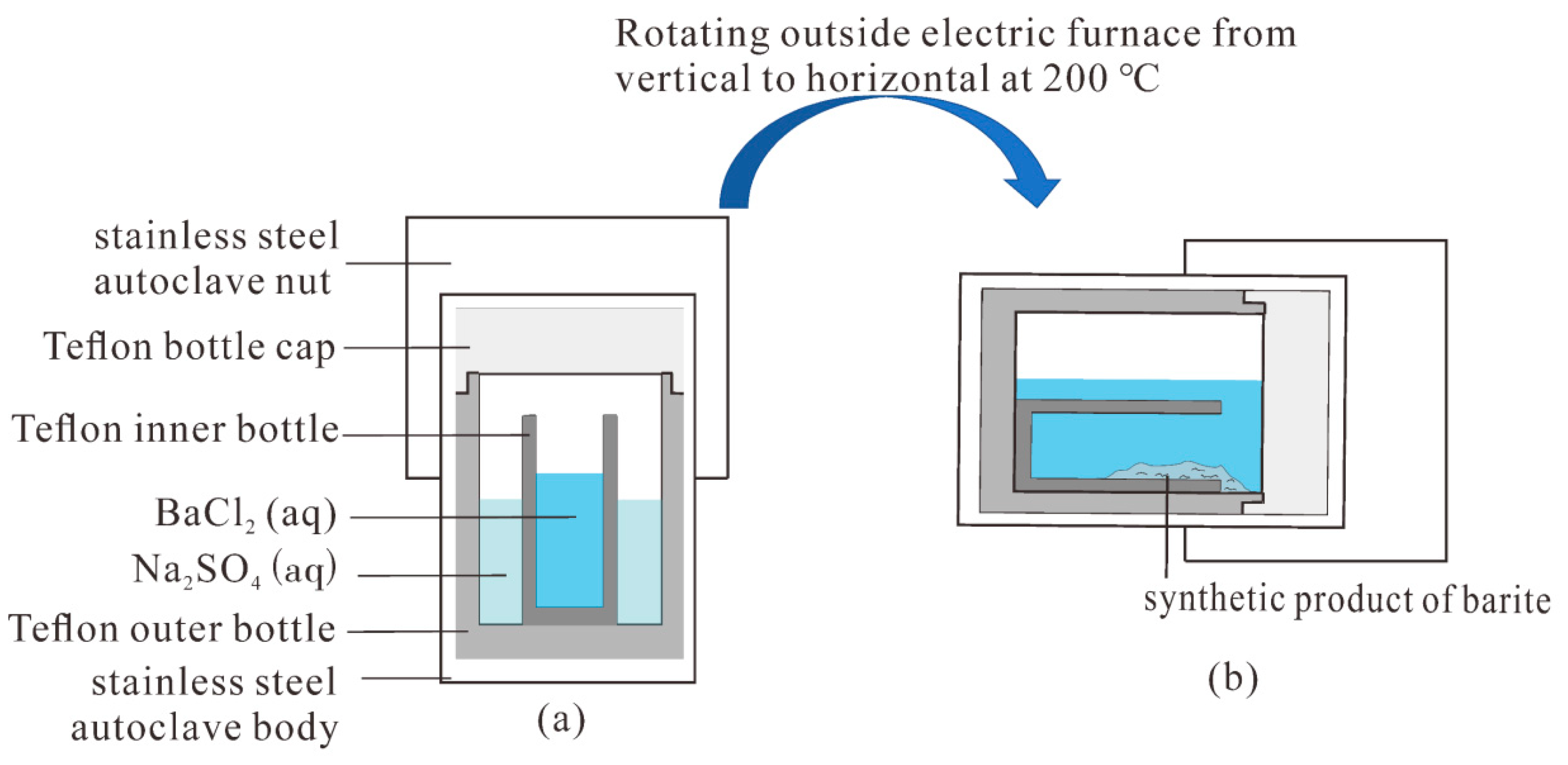
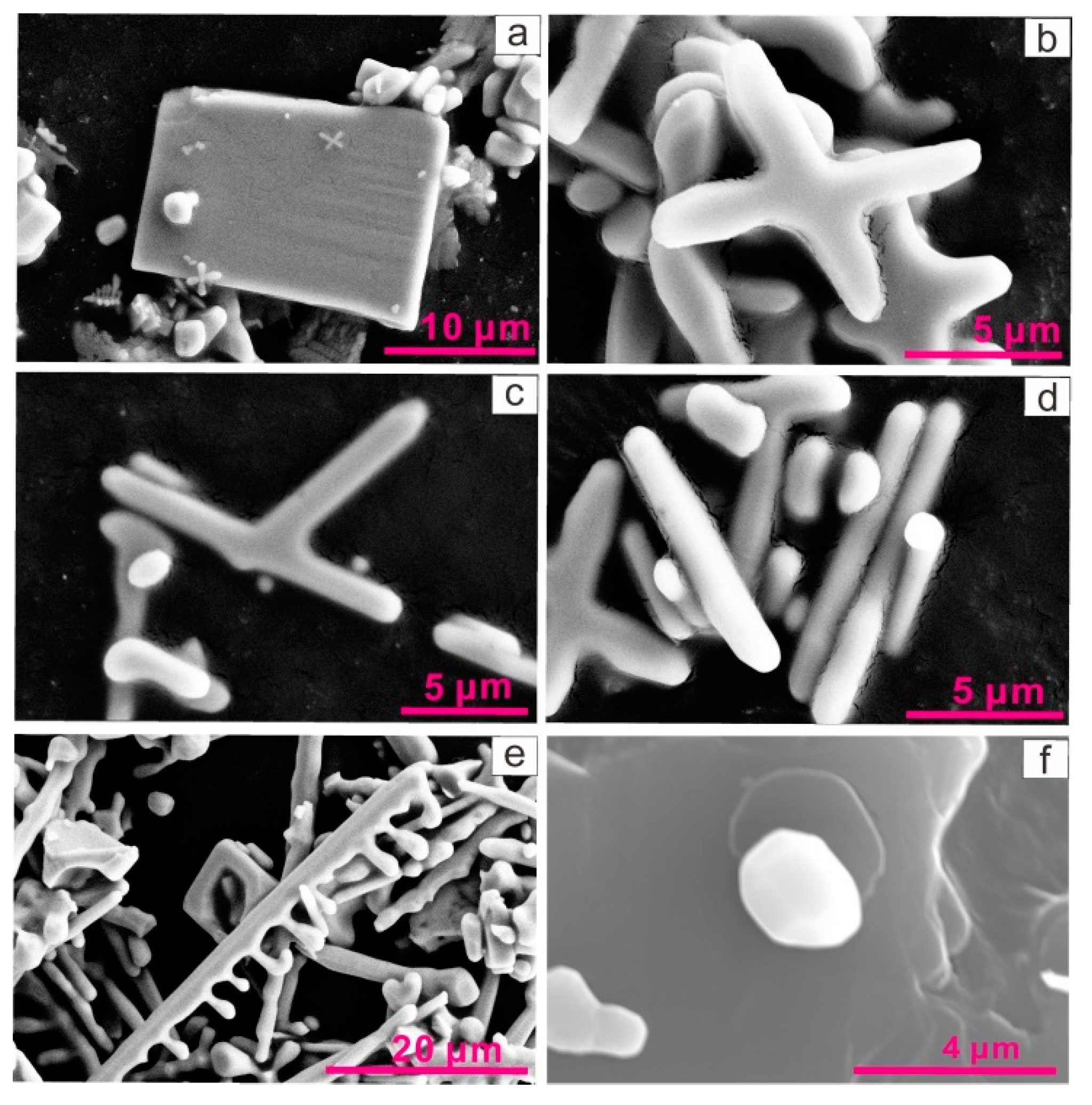
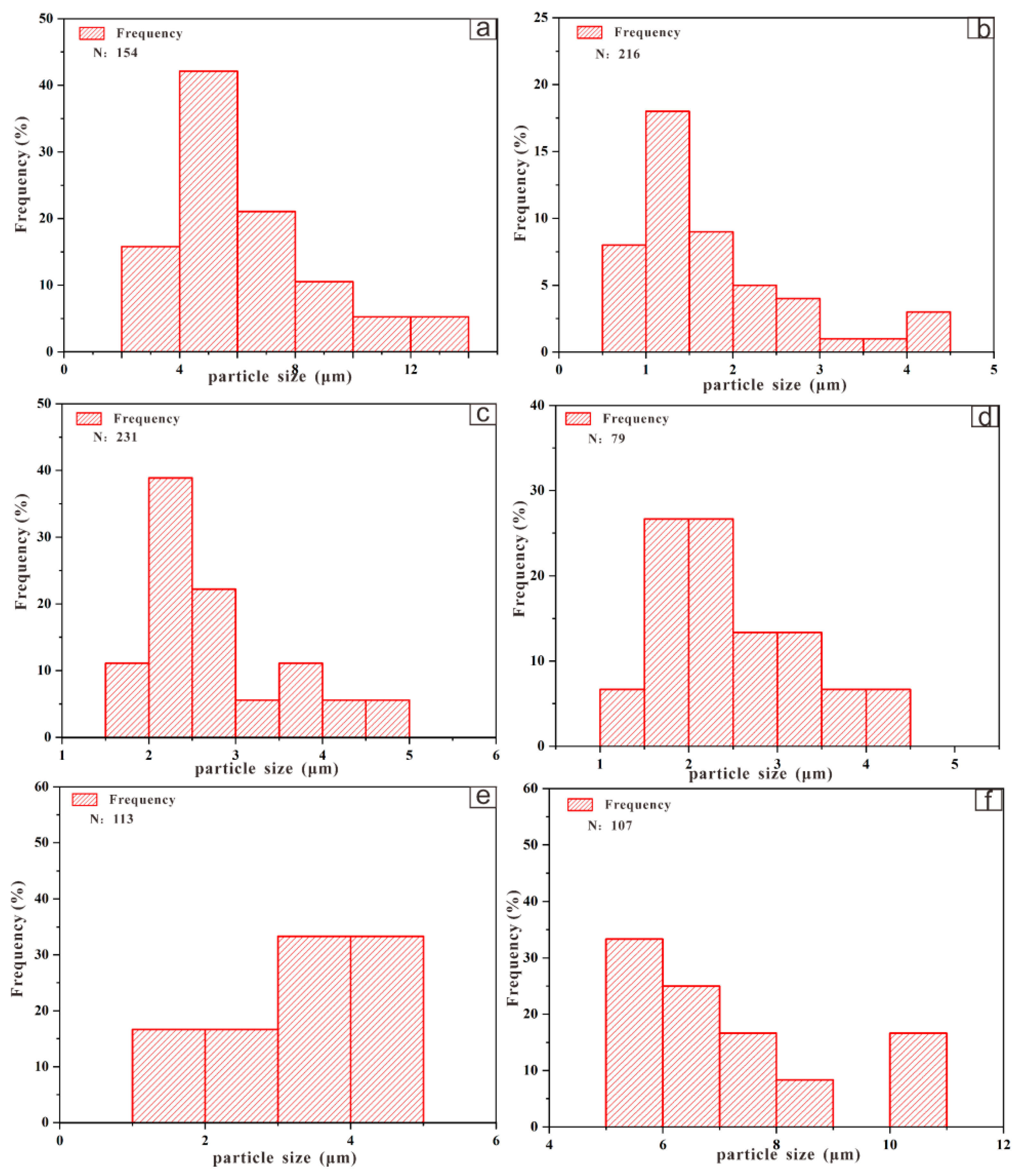
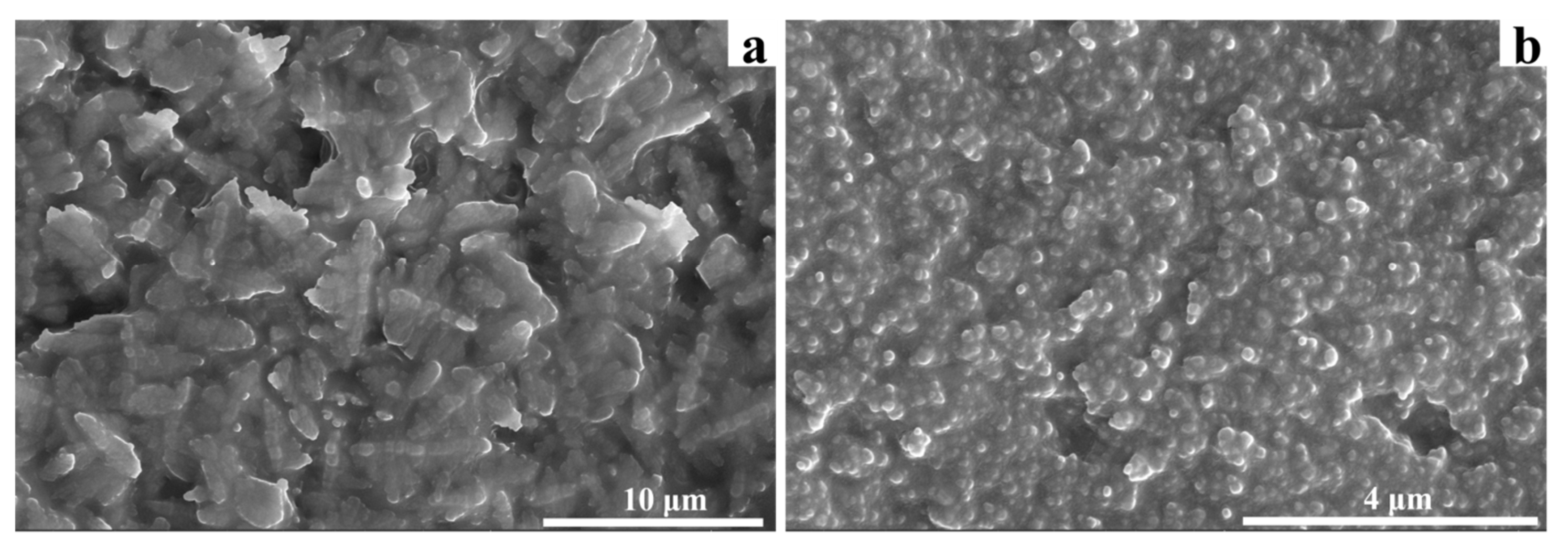
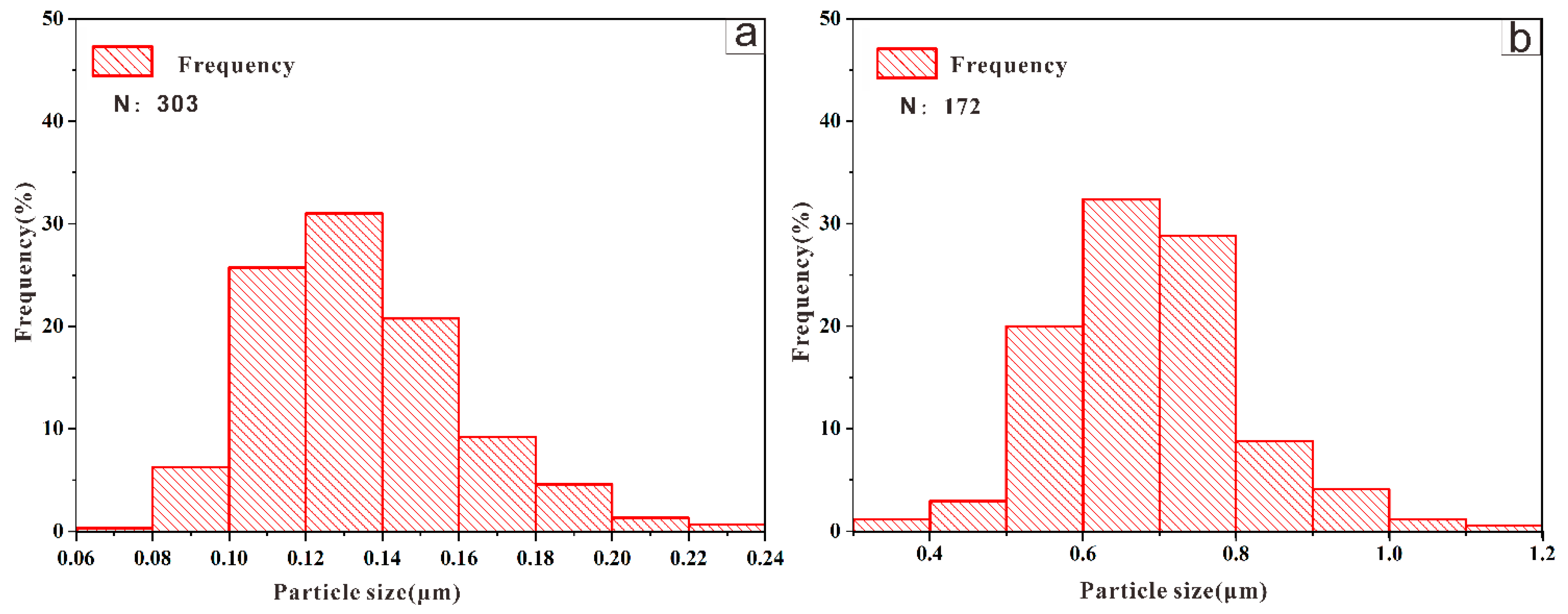

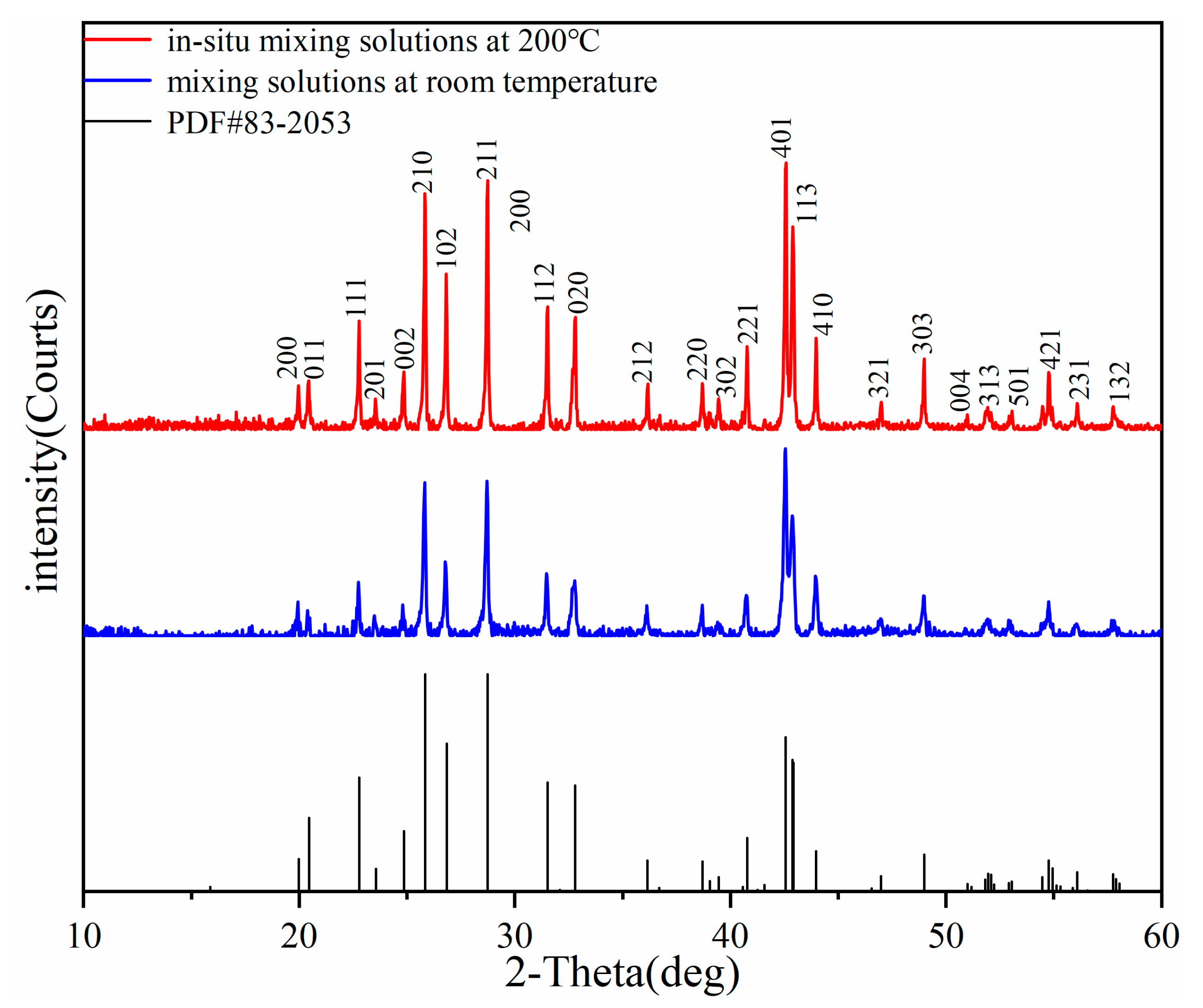
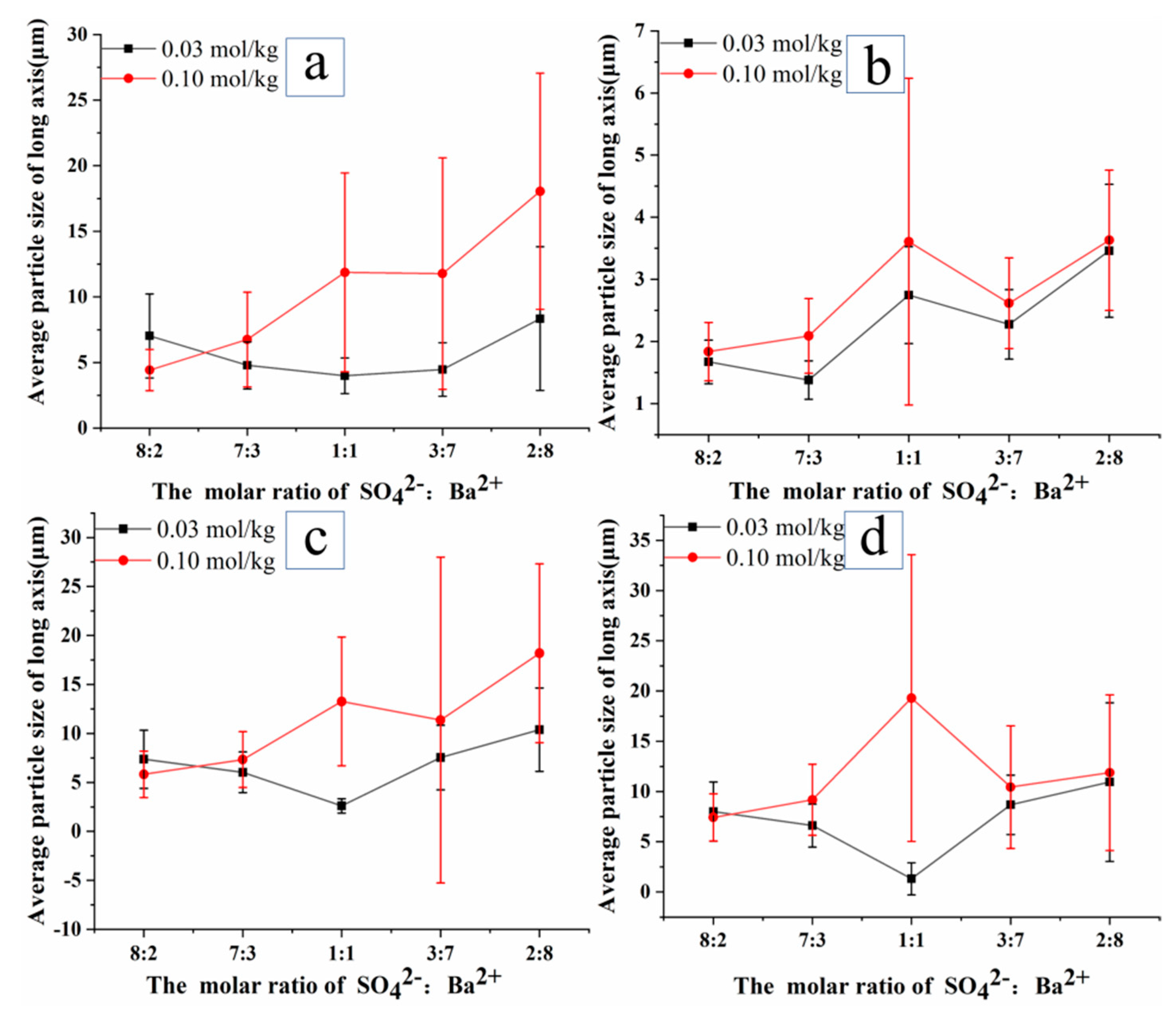
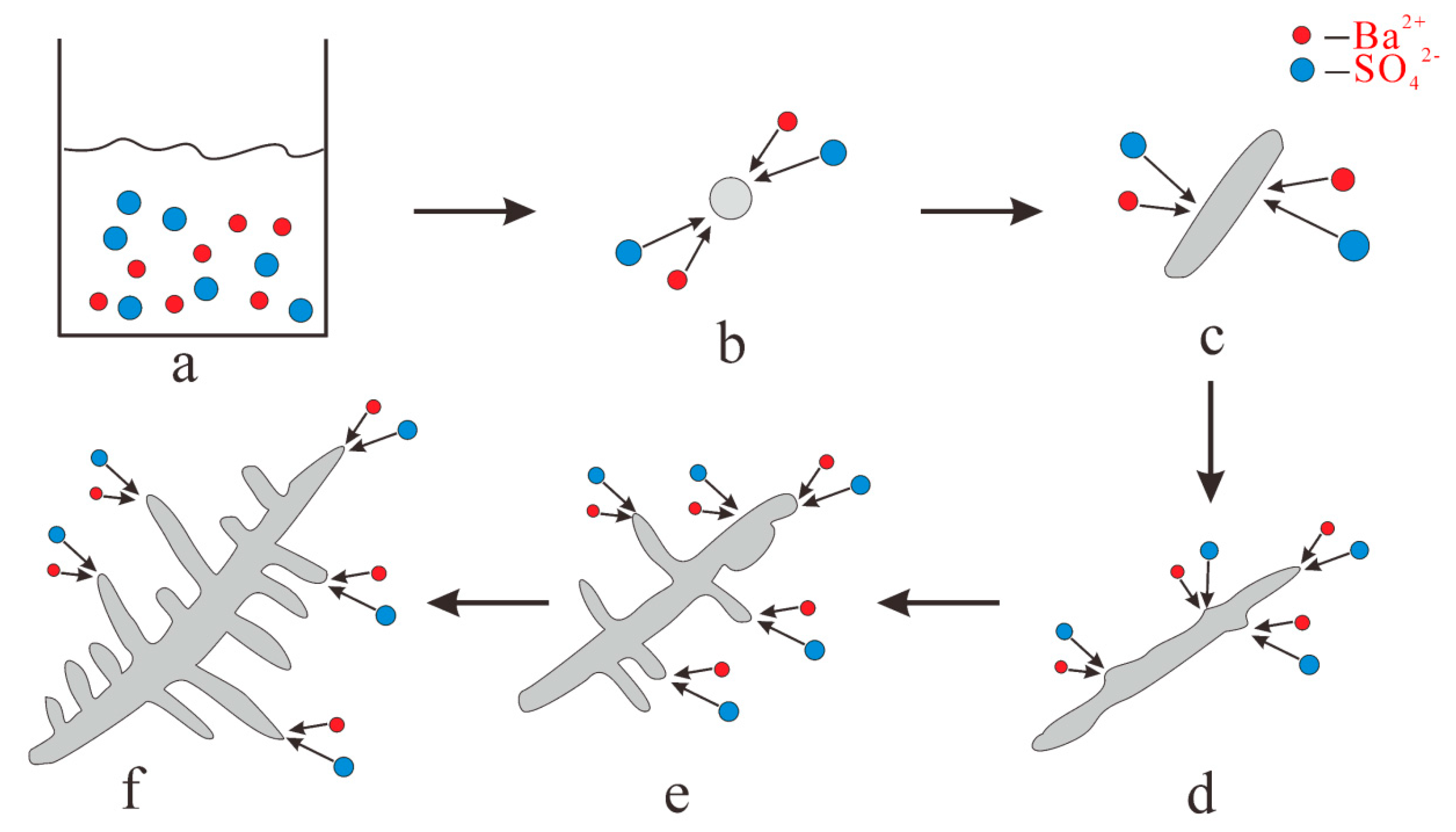
| Sample | Solution Mixing Ratio (Molar Ratio of Na2SO4 to BaCl2) | SO42− (mol/kg) | Ba2+ (mol/kg) | T(°C) |
|---|---|---|---|---|
| 1 | 8:2 | 0.03 | 0.03 | 200 |
| 2 | 7:3 | 0.03 | 0.03 | 200 |
| 3 | 1:1 | 0.03 | 0.03 | 200 |
| 4 | 3:7 | 0.03 | 0.03 | 200 |
| 5 | 2:8 | 0.03 | 0.03 | 200 |
| 6 | 8:2 | 0.1 | 0.1 | 200 |
| 7 | 7:3 | 0.1 | 0.1 | 200 |
| 8 | 1:1 | 0.1 | 0.1 | 200 |
| 9 | 3:7 | 0.1 | 0.1 | 200 |
| 10 | 2:8 | 0.1 | 0.1 | 200 |
| 11 | 8:2 | 0.03 | 0.03 | Room temperature |
| 12 | 7:3 | 0.03 | 0.03 | Room temperature |
| 13 | 1:1 | 0.03 | 0.03 | Room temperature |
| 14 | 3:7 | 0.03 | 0.03 | Room temperature |
| 15 | 2:8 | 0.03 | 0.03 | Room temperature |
| 16 | 8:2 | 0.1 | 0.1 | Room temperature |
| 17 | 7:3 | 0.1 | 0.1 | Room temperature |
| 18 | 1:1 | 0.1 | 0.1 | Room temperature |
| 19 | 3:7 | 0.1 | 0.1 | Room temperature |
| 20 | 2:8 | 0.1 | 0.1 | Room temperature |
| Synthetic Condition | Solution Mixing Ratio (Molar Ratio of Na2SO4 to BaCl2) | Morphology of Barite | |||||
|---|---|---|---|---|---|---|---|
| Rod-Shaped | Granular | Plate-Shaped | Dendritic | X-Shaped | T-Shaped | ||
| 0.03 mol/kg Na2SO4 and BaCl2 | 8:2 | + | + | - | - | + | + |
| 7:3 | + | + | - | - | + | + | |
| 1:1 | + | + | + | - | + | + | |
| 3:7 | + | + | + | - | + | + | |
| 2:8 | + | + | + | + | + | + | |
| 0.1 mol/kg Na2SO4 and BaCl2 | 8:2 | + | + | - | - | + | + |
| 7:3 | + | + | - | - | + | + | |
| 1:1 | + | + | + | - | + | + | |
| 3:7 | + | + | + | + | + | + | |
| 2:8 | + | + | + | + | + | + | |
| This Study | [31,32] | Mode Assignment | |||
|---|---|---|---|---|---|
| a | b | c | d | ||
| 453 | 453 | 452 | 453 | 453 | ν2 SO4 |
| 462 | 461 | 461 | 462 | 463 | ν2 SO4 |
| 618 | 616 | 617 | 616 | ν4 SO4 | |
| 622 | 624 | 622 | 622 | 623 | ν4 SO4 |
| 649 | 647 | 646 | 647 | 647 | ν4 SO4 |
| 988 | 988 | 989 | 987 | 988 | ν1 SO4 |
| 1083 | 1084 | 1084 | 1083 | 1083 | ν3 SO4 |
| 1103 | 1104 | 1104 | 1104 | 1105 | Unassigned |
| 1139 | 1138 | 1139 | 1138 | ν3 SO4 | |
| 1166 | 1167 | 1168 | 1167 | 1167 | ν3 SO4 |
| Synthetic Condition | Dominant Morphology | |
|---|---|---|
| Initial Reactant Concentration | Solution Mixing Ratio (SO42−/Ba2+, Molar Ratio) | |
| 0.03 mol/kg Na2SO4 and BaCl2 | 8:2 | 28.2% rod-shaped |
| 7:3 | 29.6% T-shaped | |
| 1:1 | 50.7% granular | |
| 3:7 | 32.8% granular | |
| 2:8 | 41.2% rod-shaped | |
| 0.1 mol/kg Na2SO4 and BaCl2 | 8:2 | 43.5% rod-shaped |
| 7:3 | 37.7% rod-shaped | |
| 1:1 | 61.7% rod-shaped | |
| 3:7 | 45.8% rod-shaped | |
| 2:8 | 55.4% rod-shaped | |
Publisher’s Note: MDPI stays neutral with regard to jurisdictional claims in published maps and institutional affiliations. |
© 2021 by the authors. Licensee MDPI, Basel, Switzerland. This article is an open access article distributed under the terms and conditions of the Creative Commons Attribution (CC BY) license (https://creativecommons.org/licenses/by/4.0/).
Share and Cite
Wang, C.; Zhou, L.; Zhang, S.; Wang, L.; Wei, C.; Song, W.; Xu, L.; Zhou, W. Morphology of Barite Synthesized by In-Situ Mixing of Na2SO4 and BaCl2 Solutions at 200 °C. Crystals 2021, 11, 962. https://doi.org/10.3390/cryst11080962
Wang C, Zhou L, Zhang S, Wang L, Wei C, Song W, Xu L, Zhou W. Morphology of Barite Synthesized by In-Situ Mixing of Na2SO4 and BaCl2 Solutions at 200 °C. Crystals. 2021; 11(8):962. https://doi.org/10.3390/cryst11080962
Chicago/Turabian StyleWang, Chunyao, Li Zhou, Shuai Zhang, Li Wang, Chunwan Wei, Wenlei Song, Liping Xu, and Wenge Zhou. 2021. "Morphology of Barite Synthesized by In-Situ Mixing of Na2SO4 and BaCl2 Solutions at 200 °C" Crystals 11, no. 8: 962. https://doi.org/10.3390/cryst11080962
APA StyleWang, C., Zhou, L., Zhang, S., Wang, L., Wei, C., Song, W., Xu, L., & Zhou, W. (2021). Morphology of Barite Synthesized by In-Situ Mixing of Na2SO4 and BaCl2 Solutions at 200 °C. Crystals, 11(8), 962. https://doi.org/10.3390/cryst11080962






